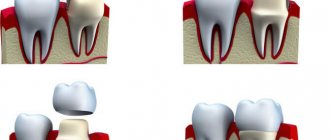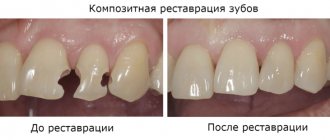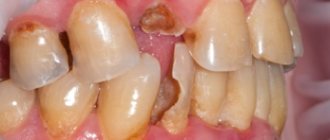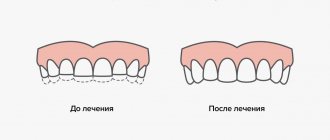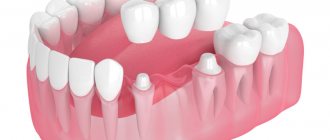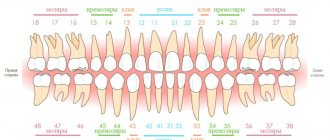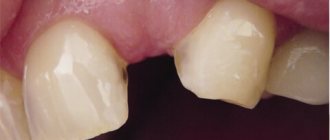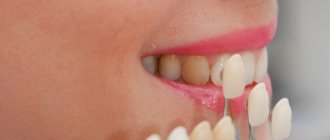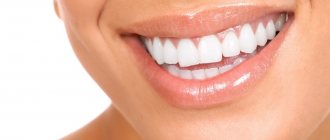- home
- Services
- Dental restoration for children
Baby teeth appear in a child from 6-9 months and are replaced by permanent teeth until the age of 12-14 years. Children's teeth, especially at an early age, are very vulnerable and susceptible to decay. It is careful attention to baby teeth that is the key to timely and correct growth of permanent dentition. A child with straight and beautiful teeth develops chewing and facial muscles correctly. Premature loss of even one baby tooth, untreated caries, crown injuries lead to the following problems:
- increased load on neighboring teeth;
- violation of growth order;
- deformations of the entire dentition;
- the occurrence of diction defects;
- deterioration of chewing function;
- aesthetic defects.
Changing the position of the rudiments of permanent teeth is a high risk of serious malocclusion, which is fraught with serious orthodontic treatment in the future. Natadent clinic specialists fight for every child’s tooth.
Indications and contraindications for tooth augmentation
Teeth augmentation is a multi-stage technology for restoring the aesthetic appearance and functions of the jaw, which was susceptible to chipping or erased as a result of increased tone of the masticatory muscles, called buxism.
Indications for the tooth augmentation procedure:
- chips resulting from injuries;
- numerous caries lesions;
- large distance between teeth;
- wedge-shaped defect;
- the presence of a gap between the two front teeth;
- congenital structural pathologies;
- thinning and demineralization of enamel due to consumption of junk food and lack of oral hygiene;
- cervical caries;
- the presence of errors in previous dental sessions that resulted in the destruction of healthy tissue;
- malocclusion.
Having asked the dentist a question about what tooth extension is called, the patient will immediately hear the answer. The procedure is called dentition restoration. Modern extension technologies make it possible to restore the structure in most cases without resorting to its removal. The procedure is harmless, but has a number of contraindications:
- patient age – more than 60 years;
- children's age when using pins;
- presence of a cyst;
- inflammation of the gums;
- pregnancy in the first or third trimester;
- failure to comply with personal hygiene rules;
- periodontitis and stomatitis;
- jaw fracture and other injuries.
If a patient is diagnosed with diseases that are contraindications, the dentist first treats them, and then restores the dentition.
Prevention
No one is immune from accidental dental injuries. To minimize the likelihood of crack formation, you must:
- adhere to a diet with sufficient calcium, fluorine, and other microelements;
- avoid situations where the tooth is exposed to stress (do not chew nuts, do not try to open bottles with your teeth);
- do not try to whiten enamel at home, including using abrasive pastes;
- Visit your dentist regularly for monitoring.
A cracked tooth is an unpleasant occurrence for both children and adults, but it can and should be dealt with. The Department of Dentistry of the SM-Doctor clinic invites very young patients and teenagers to visit. We will find obvious and hidden defects in tooth enamel and select effective treatment. Call and make an appointment with the dentist now.
Teeth extension methods
There are 2 main extension methods:
- Straight. Used if tooth decay is up to 30%. During the procedure, composite or photopolymer materials are used to build teeth. The former are less durable and harden after 30 minutes. The latter have a service life of 10 years and remain plastic until exposed to the lamp.
- Indirect. Applicable when damage affects no more than 70% of the structure. The method has several stages, including taking impressions, making and installing ceramic inlays.
If you have ever thought about whether a crown or extension is better, then you should know that a crown is installed when more than 70% of the tissue is destroyed, but a intact and healthy root remains.
Why do they put crowns on baby teeth?
“Why do you need to get a crown?” or “Baby teeth, why a crown?” or “Let’s get a filling anyway, a crown is strange, it’s for adults.” Pediatric dentists hear these questions and statements every day, and this is normal, because not everyone knows about the need for prosthetics in the primary and secondary dentition. I would like to tell you more about this.
I want to say right away that we will talk about metal crowns for the chewing group of teeth and zirconium dioxide crowns for the front milk teeth.
The main difference between “baby crowns” and crowns for permanent teeth is that crowns for milk teeth are standard and vary in size, therefore, when trying on the crown itself, you need to select a “hat” according to the size of the tooth without lengthy manipulations, when for adults it is necessary to take impressions and using them in the laboratory to make a crown suitable only for the causative tooth.
Why a crown and not a filling? The tooth must chew, this is its main function. During chewing, the load is distributed evenly over the chewing surface. If the tooth is partially restored with a filling and its volume does not exceed 50%, then the natural tissues of the tooth are able to take on part of the load that is transferred to them from the missing tissues. If the damage is more than 50% and/or the tooth is dead, then the remaining tissues may not withstand the incoming load, the remaining walls of the tooth and the filling itself chip, while the crown remains intact, which is an absolute advantage.
Another advantage of the crown is the complete sealing of the material that was used during endodontic treatment of the tooth.
Do not forget about the possibility of recurrence of caries, which can occur under a filling. As a rule, this is due to a violation of the seal. Such fillings, of course, must be replaced. If the tooth is restored with a crown, then this does not happen.
It happens that the germ of a permanent tooth is missing and therefore the baby tooth needs to be “kept” in its place for as long as possible. If the tooth is healthy, then a crown is not required, the main thing is good hygiene. And if the tooth was previously treated for caries and the filling is no longer sound, then it is more advisable to restore this tooth with a crown to prevent further destruction.
Another reason for using crowns is circular caries, which most often occurs in children due to poor hygiene. There is always a large amount of plaque in the cervical area of the tooth, which leads to the appearance of white spots and further caries along the entire perimeter of the tooth. A crown, like a cap, protects all surfaces of the tooth.
To summarize: the crown performs the function of uniformly distributing the chewing load, protects the tooth from further destruction and provides complete sealing to eliminate the likelihood of caries. Unfortunately, the filling does not cope with such tasks so successfully.
Why metal? A child is a growing organism and this is its natural state and feature that should be taken into account. The relationship between the jaws and teeth in the oral cavity also changes and that is why there is such a thing as “physiological abrasion.” What does it mean? The cusps and cutting edges of the teeth begin to flatten over time due to constant contact with antagonist teeth during chewing and speech. Now imagine what will happen if a tooth with a crown does not undergo any changes over time... physiological changes in the entire dental system will be disrupted. That is why metal was chosen for the crowns of baby teeth, which, like natural tooth tissue, is able to adapt to changes in the child’s bite.
“How do children feel about metal crowns? I probably don’t like it, it’s not convenient, a complex may arise.” No, you’re wrong. Children are usually very proud of their “iron teeth” and show it to their peers, so this psychological aspect is not at all traumatic. It is important to note that the child feels your attitude, which means that your personal attitude should be positive. Praise and approval will add positive energy, which means the child will be happy to show off his new acquisition. After all, now he is a bit of an “iron man.”
Summarizing all of the above, we can deduce the indications for restoring children’s teeth with crowns:
- Tooth decay more than 50%
- Pulpless teeth and teeth with partial nerve amputation
- Circular caries
- Absence of permanent tooth germ (relative indication)
Regarding the frontal group of teeth, the readings remain the same, only the material changes - zirconium dioxide. This is the most aesthetic material, which is practically indistinguishable from natural teeth and will give the baby a beautiful smile.
A crown is not scary, it is a guarantee of long service life of the tooth, as well as its functionality and aesthetics.
Features of front teeth extensions
Restoration of anterior teeth is carried out in the following cases:
- Yellowing of enamel;
- Damage to caries;
- Minor curvature;
- Presence of chips or chips;
- Grayish-yellow coating.
Composites and photopolymers are used for extensions, but veneers are the most popular. They are used for minor damage to healthy tissue. If the tooth body is deeply damaged, it is removed from the roots and an implant is implanted in its place. Types of veneers presented in our clinic: composite veneers, ceramic veneers.
Chips of baby teeth often occur in childhood. Many parents do not pay attention to this, hoping for the speedy growth of indigenous children. This is wrong, as the sharp edges scratch the tongue, causing inflammation and infection. Children's extensions are made using composite materials and are absolutely painless.
Typology of dental trauma
If a piece of a tooth breaks, the fragments can trap the enamel when destroyed. In these cases, the tooth breaks open or closed, and the pulp may open. Tooth injuries are distinguished by the area of the fracture - at the root, on top, etc. In case of injury, when a piece may break off, the tooth is often displaced.
The nature of the damage depends on the size of the chipped part, for example, if a child’s upper wisdom tooth is half broken:
- minimal degree of injury;
- average degree of injury;
- severe degree of injury.
When a tooth is damaged, the enamel is often affected. This is a minimal type of injury when the internal layers are not affected. The opposite indicates the average severity of the tooth fracture. In such a situation, the damage touches the pulp and the nerve is affected.
Let's look at the main types of dental damage. This is important for understanding what to do if a piece of a tooth breaks off.
1. The tooth broke in the root zone . The child’s tooth root is not yet strong enough to be difficult to remove.
The greatest risk, as always, falls on the upper front incisors. In order to determine why a child’s baby tooth has broken off, modern diagnostics will be required. A tooth fracture in the root area is determined by a series of x-rays. It is detected, as a rule, with the appearance of characteristic sensations due to inflammation of the gums. Depending on the degree of root destruction, the pulp will be affected, and this already leads to more serious consequences.
2. If a front tooth breaks off, and it is a baby tooth . Most often, a small piece breaks off from a small tooth. This can happen for various reasons. The doctor will determine the degree of danger. If the crown under the root is broken, the tooth will have to be removed. When a tooth chips away from the root, cosmetic restoration can be used to solve the problem. Usually the dentist performs extensions.
Often a tooth is displaced or dislocated as a result of a side blow to the jaw. For example, a child hit something when falling or another child accidentally touched it, and your child’s front tooth broke off. As a result, gum swelling may occur. The entry of microbes into the wound leads to the loss of a tooth, even if it is a milk tooth. It can be restored, but to do this it must be preserved in warm milk or saline until the implantation procedure.
Tooth extension onto a pin
When thinking about whether it is possible to build a tooth onto the root, the use of a pin comes to mind. It is used if both the body and the root are severely damaged.
The procedure includes:
- obtaining an x-ray;
- cleaning the mouth, removing stones;
- removal of damaged areas;
- computer tooth modeling;
- removal of saliva;
- anesthesia;
- cleaning of channels;
- implantation of a pin, cleansing the area around it;
- filling the space around the pin with a composite or photopolymer;
- polishing and grinding.
Dentists build up teeth under crowns only if the remainder is in good condition and does not rot or decompose.
Treatment of cracked teeth in children
The choice of treatment method depends on the age of the child, type of tooth (baby or permanent), location, depth and extent of the defect. Dentists have the following options at their disposal:
- grinding and polishing of enamel followed by application of protective and remineralizing components;
- restoration with filling material;
- installation of a veneer or crown (on a permanent bite);
- removal of a problematic tooth.
Simultaneously with the immediate elimination of the defect, the provoking factor is treated: nutritional correction, saturation of the enamel with minerals, etc.
Does it hurt to grow teeth?
Tooth extension is a painless procedure. Anesthesia is not performed if the damage is not significant, since manipulations are carried out at a superficial level. If the damage is severe, the dentist administers local anesthesia. Modern drugs begin to act immediately after administration.
After the session, the first day you may experience pain if the canals were cleaned. Painkillers will help you feel better.
The restored dentition will last a long time if the patient provides proper care. If the question arises about whether it is possible to smoke after tooth extensions, the answer will be negative. Composite and photopolymer materials quickly absorb all substances, which is why the filling quickly changes color. Maintaining hygiene and regular visits to the dentist will help you maintain your smile for a long time.
general information
Tooth enamel has high hardness and strength. This property allows you to reliably protect the underlying layers from mechanical damage and inflammation. However, in some cases, intense mechanical stress can lead to cracking of the enamel. Shallow and short defects often go unnoticed, but without treatment over time they become deeper and darker in color. Without treatment, cracks can become entry points for infection - through damaged enamel, pathogenic bacteria penetrate into dentin and pulp, causing extensive inflammation.
Both children and adults face the problem of enamel cracks. Regardless of the patient’s age, it is important not to delay a visit to the dentist so that the destruction does not progress.
